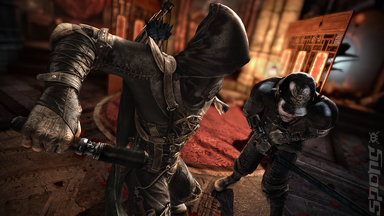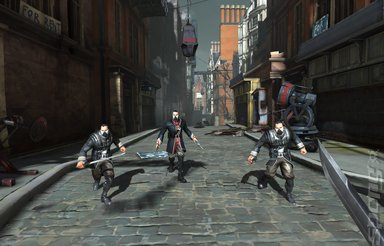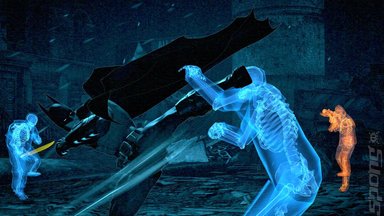Another example, picked up by the Toronto Sun in its review, is the fact that Garrett can pick up seemingly endless quantities of loot and yet can only add one glass bottle to his inventory at a time. Here, it would be perfectly plausible to accept that Garrett could only carry so much kit. He's not a massive chap, and he doesn't want to be over-burdened with thieving tackle when he's got all that sneaking around to do.
Except that when it comes to swiping gold coins and hair brushes, Garrett seems to have TARDIS pockets. Restricting what he can carry in no way breaches tried and tested conventions of gaming, but it does go against something Eidos Montreal has established in this very game. And, again, the effect is jarring and can have the effect of kicking your suspension of disbelief right in the nuts.
I might also point to the AI and its apparent shortsightedness as soon as it's more than an in-game foot or two from the nearest candle. Or perhaps its propensity for repeating dialogue. Or the fact that once they've spotted you, Watch members will, sooner or later, get bored and stand down, or maybe decide it's just not worth chasing you through that door. Doors are tricky, guys. (Thief is, I should note, actually better than a lot of stealth games for keeping that 'code red' enemy state going).
All of these things would have been forgivable to the point that you probably wouldn't even notice them if Thief were a game built out of 2D sprites, but because the AI is actually very good in a lot of ways (the animation, how it reacts to you, the scripting and voice acting) it's incredibly jarring when it screws up.
Thief is not, of course, the only offender for this. It's probably not the worst, either. It's just the example I happen to be using. There are, however, more elegant ways to deal with some of these problems.
Navigating the city, for example, is a little frustrating in Thief. While we're given the impression of an open world and some elbow room when making our way from one destination to the next, we're periodically presented with a strange glowing light and a caption asking if we do, in fact, want to enter this next area. Poof! There goes your immersion.
I get that creating a genuinely open world with a lot of map and a lot to do in it is a massive job and, often, probably not worth the effort. And, hey, at least Eidos didn't block our way with invisible walls (I can't believe that's still a thing). But a far more elegant solution would be something like we get in the Thief-inspired Dishonored, where if Arkane didn't want to have to deal with a particular part of the city, it stuck up a barricade. Dunwall was overrun with civic strife, so it was a perfect fit with Dishonored's premise and Arkane was left to work on a tight, focused game world that doesn't have many of its seams showing.
Or then there's Garrett's focus, which highlights elements of the environment that he can use to his advantage. In weird, glowing blue. This is hardly a game breaker, but it's just one more glaringly noticeable design element in a world that otherwise feels quite natural. The Batman: Arkham games deal with this issue very effectively by having Bats' 'detective vision' be based on technology, which makes it perfectly plausible that his software highlight level elements of interest.
However, it has to be acknowledged that not every game can have a pair of high-tech goggles or a civil conflict to steer the player. And introducing such elements to a game can be unwieldy. I can't imagine that a game designed entirely around giving its lead character some ability or tool to help him navigate the environment would be much cop.
Except that when it comes to swiping gold coins and hair brushes, Garrett seems to have TARDIS pockets. Restricting what he can carry in no way breaches tried and tested conventions of gaming, but it does go against something Eidos Montreal has established in this very game. And, again, the effect is jarring and can have the effect of kicking your suspension of disbelief right in the nuts.
I might also point to the AI and its apparent shortsightedness as soon as it's more than an in-game foot or two from the nearest candle. Or perhaps its propensity for repeating dialogue. Or the fact that once they've spotted you, Watch members will, sooner or later, get bored and stand down, or maybe decide it's just not worth chasing you through that door. Doors are tricky, guys. (Thief is, I should note, actually better than a lot of stealth games for keeping that 'code red' enemy state going).
All of these things would have been forgivable to the point that you probably wouldn't even notice them if Thief were a game built out of 2D sprites, but because the AI is actually very good in a lot of ways (the animation, how it reacts to you, the scripting and voice acting) it's incredibly jarring when it screws up.
Thief is not, of course, the only offender for this. It's probably not the worst, either. It's just the example I happen to be using. There are, however, more elegant ways to deal with some of these problems.
Navigating the city, for example, is a little frustrating in Thief. While we're given the impression of an open world and some elbow room when making our way from one destination to the next, we're periodically presented with a strange glowing light and a caption asking if we do, in fact, want to enter this next area. Poof! There goes your immersion.
I get that creating a genuinely open world with a lot of map and a lot to do in it is a massive job and, often, probably not worth the effort. And, hey, at least Eidos didn't block our way with invisible walls (I can't believe that's still a thing). But a far more elegant solution would be something like we get in the Thief-inspired Dishonored, where if Arkane didn't want to have to deal with a particular part of the city, it stuck up a barricade. Dunwall was overrun with civic strife, so it was a perfect fit with Dishonored's premise and Arkane was left to work on a tight, focused game world that doesn't have many of its seams showing.
Or then there's Garrett's focus, which highlights elements of the environment that he can use to his advantage. In weird, glowing blue. This is hardly a game breaker, but it's just one more glaringly noticeable design element in a world that otherwise feels quite natural. The Batman: Arkham games deal with this issue very effectively by having Bats' 'detective vision' be based on technology, which makes it perfectly plausible that his software highlight level elements of interest.
However, it has to be acknowledged that not every game can have a pair of high-tech goggles or a civil conflict to steer the player. And introducing such elements to a game can be unwieldy. I can't imagine that a game designed entirely around giving its lead character some ability or tool to help him navigate the environment would be much cop.
Read More Like This
Comments
The limits on "things with which to distract" really hacked me off in Last of Us.
Here I am, surrounded by detritus most of which could be suitably lobbed, yet the game enforced this fanciful rule that only brick and bottles can serve to distract. It wasn't even like there was a massive scarcity of bricky bottleness, but when I was caught short, the inability to hoist anything luggable shattered the immersion.
Here I am, surrounded by detritus most of which could be suitably lobbed, yet the game enforced this fanciful rule that only brick and bottles can serve to distract. It wasn't even like there was a massive scarcity of bricky bottleness, but when I was caught short, the inability to hoist anything luggable shattered the immersion.
I think gamers have, and are entitled to a sense we should be abandoning some of the tropes and crutches game developers have used in the past, invisible walls, using hordes of braindead, impotent enemies in place of intelligent AI, forcing players to start in the back of the pack in racing games, "monster closets", doors and windows which cannot be interacted with for no apparent reason...these are all things that had their day and were accepted without comment in the past, but we expect better now. Take some time out from making sure that you have the latest high definition texture maps, and think about what you're doing with them...



